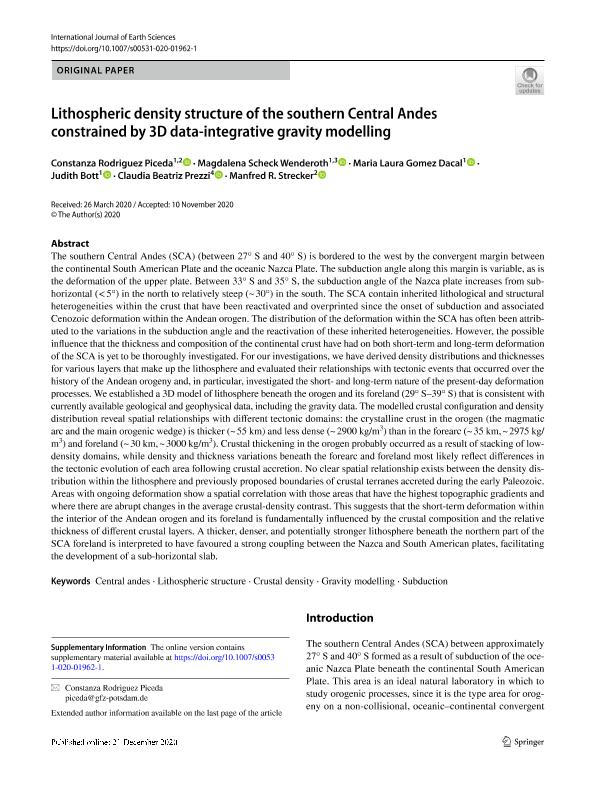Mostrar el registro sencillo del ítem
dc.contributor.author
Rodriguez Piceda, Constanza

dc.contributor.author
Scheck Wenderoth, Magdalena
dc.contributor.author
Gómez Dacal, María Laura

dc.contributor.author
Bott, Judith
dc.contributor.author
Prezzi, Claudia Beatriz

dc.contributor.author
Strecker, Manfred R.
dc.date.available
2021-10-01T23:49:51Z
dc.date.issued
2020-12-21
dc.identifier.citation
Rodriguez Piceda, Constanza; Scheck Wenderoth, Magdalena; Gómez Dacal, María Laura; Bott, Judith; Prezzi, Claudia Beatriz; et al.; Lithospheric density structure of the southern Central Andes constrained by 3D data-integrative gravity modelling; Springer; International Journal of Earth Sciences; 110; 7; 21-12-2020; 2333-2359
dc.identifier.issn
1437-3254
dc.identifier.uri
http://hdl.handle.net/11336/142322
dc.description.abstract
The southern Central Andes (SCA) (between 27° S and 40° S) is bordered to the west by the convergent margin between the continental South American Plate and the oceanic Nazca Plate. The subduction angle along this margin is variable, as is the deformation of the upper plate. Between 33° S and 35° S, the subduction angle of the Nazca plate increases from sub-horizontal (< 5°) in the north to relatively steep (~ 30°) in the south. The SCA contain inherited lithological and structural heterogeneities within the crust that have been reactivated and overprinted since the onset of subduction and associated Cenozoic deformation within the Andean orogen. The distribution of the deformation within the SCA has often been attributed to the variations in the subduction angle and the reactivation of these inherited heterogeneities. However, the possible influence that the thickness and composition of the continental crust have had on both short-term and long-term deformation of the SCA is yet to be thoroughly investigated. For our investigations, we have derived density distributions and thicknesses for various layers that make up the lithosphere and evaluated their relationships with tectonic events that occurred over the history of the Andean orogeny and, in particular, investigated the short- and long-term nature of the present-day deformation processes. We established a 3D model of lithosphere beneath the orogen and its foreland (29° S–39° S) that is consistent with currently available geological and geophysical data, including the gravity data. The modelled crustal configuration and density distribution reveal spatial relationships with different tectonic domains: the crystalline crust in the orogen (the magmatic arc and the main orogenic wedge) is thicker (~ 55 km) and less dense (~ 2900 kg/m3) than in the forearc (~ 35 km, ~ 2975 kg/m3) and foreland (~ 30 km, ~ 3000 kg/m3). Crustal thickening in the orogen probably occurred as a result of stacking of low-density domains, while density and thickness variations beneath the forearc and foreland most likely reflect differences in the tectonic evolution of each area following crustal accretion. No clear spatial relationship exists between the density distribution within the lithosphere and previously proposed boundaries of crustal terranes accreted during the early Paleozoic. Areas with ongoing deformation show a spatial correlation with those areas that have the highest topographic gradients and where there are abrupt changes in the average crustal-density contrast. This suggests that the short-term deformation within the interior of the Andean orogen and its foreland is fundamentally influenced by the crustal composition and the relative thickness of different crustal layers. A thicker, denser, and potentially stronger lithosphere beneath the northern part of the SCA foreland is interpreted to have favoured a strong coupling between the Nazca and South American plates, facilitating the development of a sub-horizontal slab.
dc.format
application/pdf
dc.language.iso
eng
dc.publisher
Springer

dc.relation
http://hdl.handle.net/11336/184921
dc.rights
info:eu-repo/semantics/openAccess
dc.rights.uri
https://creativecommons.org/licenses/by-nc-sa/2.5/ar/
dc.subject
CENTRAL ANDES
dc.subject
CRUSTAL DENSITY
dc.subject
GRAVITY MODELLING
dc.subject
LITHOSPHERIC STRUCTURE
dc.subject
SUBDUCTION
dc.subject.classification
Geoquímica y Geofísica

dc.subject.classification
Ciencias de la Tierra y relacionadas con el Medio Ambiente

dc.subject.classification
CIENCIAS NATURALES Y EXACTAS

dc.title
Lithospheric density structure of the southern Central Andes constrained by 3D data-integrative gravity modelling
dc.type
info:eu-repo/semantics/article
dc.type
info:ar-repo/semantics/artículo
dc.type
info:eu-repo/semantics/publishedVersion
dc.date.updated
2021-04-28T21:03:51Z
dc.journal.volume
110
dc.journal.number
7
dc.journal.pagination
2333-2359
dc.journal.pais
Alemania

dc.journal.ciudad
Berlín
dc.description.fil
Fil: Rodriguez Piceda, Constanza. German Research Centre for Geosciences; Alemania. Universitat Potsdam; Alemania
dc.description.fil
Fil: Scheck Wenderoth, Magdalena. German Research Centre for Geosciences; Alemania. RWTH Aachen University; Alemania
dc.description.fil
Fil: Gómez Dacal, María Laura. German Research Centre for Geosciences; Alemania. Universidad Nacional de La Plata. Facultad de Ciencias Astronómicas y Geofísicas; Argentina. Consejo Nacional de Investigaciones Científicas y Técnicas. Centro Científico Tecnológico Conicet - La Plata; Argentina
dc.description.fil
Fil: Bott, Judith. German Research Centre for Geosciences; Alemania
dc.description.fil
Fil: Prezzi, Claudia Beatriz. Consejo Nacional de Investigaciones Científicas y Técnicas. Oficina de Coordinación Administrativa Ciudad Universitaria. Instituto de Geociencias Básicas, Aplicadas y Ambientales de Buenos Aires. Universidad de Buenos Aires. Facultad de Ciencias Exactas y Naturales. Instituto de Geociencias Básicas, Aplicadas y Ambientales de Buenos Aires; Argentina
dc.description.fil
Fil: Strecker, Manfred R.. German Research Centre for Geosciences; Alemania. Universitat Potsdam; Alemania
dc.journal.title
International Journal of Earth Sciences

dc.relation.alternativeid
info:eu-repo/semantics/altIdentifier/url/http://link.springer.com/10.1007/s00531-020-01962-1
dc.relation.alternativeid
info:eu-repo/semantics/altIdentifier/doi/http://dx.doi.org/10.1007/s00531-020-01962-1
Archivos asociados
